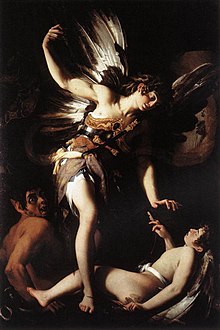Giovanni Baglione
Giovanni Baglione | |
|---|---|
Mannerist, Baroque |

Giovanni Baglione (Italian: [d͡ʒoˈvan.ni baʎˈʎoː.ne]; 1566 – 30 December 1643) was an Italian Late Mannerist and Early Baroque painter and art historian. Although a prolific painter, Baglione is best remembered for his encyclopedic collection of biographies of the other artists working in Rome during his lifetime, and particularly his acrimonious relationship with the slightly younger artist Caravaggio through his art and writings.
Life
He was born and died in Rome, but from his own account came from a noble family of
He spent 1621–1622 in Mantua as the court artist of Duke Ferdinando Gonzaga, where the exposure to the fabulous Gonzaga collection of Venetian paintings influenced his style.[2] Otherwise he remained in Rome, where he was long successful in attracting commissions from the Papal court and aristocracy. His paintings have been described by the art historian Steven F. Ostrow as "extraordinarily uneven, at best, competent, and his work pales in comparison with that of many of the contemporary artists he emulated", while his "chalk and pen and ink drawings reveal a force and lyricism rarely found in his paintings".[3] The quality of his work declined sharply in the 1630s, by which time he was in his late sixties.[4]
He had a successful career, receiving a
Writings


He published two books, The nine churches of Rome (Le nove chiese di Roma 1639),[7] and The Lives of Painters, Sculptors, Architects and Engravers, active from 1572–1642 (Le Vite de' Pittori, scultori, architetti, ed Intagliatori dal Pontificato di Gregorio XII del 1572. fino a' tempi de Papa Urbano VIII. nel 1642, 1642). The latter is still seen as an important historical source for artists living in Rome during the lifetime of Baglione. His first book was an artistic guide to Rome's nine major pilgrimage churches, which is notable for its period in taking an interest in the works of all periods, and remains useful to scholars as an account of these churches at a point before many subsequent alterations. It "marks a watershed in the guidebook literature of Rome-the turning point between the older tradition of devotional guidebooks ... and the modern tradition of artistic guides".[8]
His biographies cover
Litigation against Caravaggio
Baglione's best known painting, Sacred Love and Profane Love (or The Divine Eros Defeats the Earthly Eros and other variants), was a direct response to
In late August 1603 Baglione filed a suit for
Paintings
He was mainly a painter of religious subjects, reflecting the Roman market, but also painted several mythological subjects, including an "astonishing" Venus whipped by Love (1620s) with an unusually suggestive pose, accentuated by strong
He was employed in many of the considerable numbers of church commissions in Rome during the pontificates of
Gallery
-
The Ecstasy of St Francis, 1601, Art Institute of Chicago
-
Saint Sebastian healed by an angel, c. 1603, private collection
-
Euterpe (from the series Apollo and the Muses, 1621-1623)
-
San Sebastiano cared for by angels, 1624, Santa Maria dell'Orto
-
Hercules at the crossroads, 1640-1642, National Gallery of Slovenia, Ljubljana
See also
- Artists in biographies by Giovanni Baglione
- Sacred-profane dichotomy
Notes
- ^ O'Neill; Wittkower, who relegates his account of Baglione's style to a note at n. 9, p. 514, and p. 74
- ^ O'Neill
- ^ Ostrow, 609
- ^ Wittkower, citing Carla Guigliemi (1954), n. 9, p. 514
- ^ Ostrow, 609, Dictionary
- ^ Dictionary
- ^ Giovanni Baglione (1639). Le noue chiese di Roma, di Giouanni caualier Baglione romano dell'habito di Christo. Nelle quali si contengono le historie pitture scolture, & architetture di esse. per Andrea Fei.
- ^ Ostrow, 609, quoted; Dictionary
- ^ Ostrow, 609; Dictionary
- ^ Ostrow, 609, quoting Joseph Connor at the start.
- ^ O'Neil
- ^ Ostrow, 608; Gemäldegalerie, Berlin, Prestel, 148; Wittkower, 74
- ISBN 0714839663.
- ^ Ostrow, 608 (with Caravaggio quotes); Dictionary (quotes Gentileschi)
- ^ Ostrow, 608, quoted; image
- ^ Wittkower, 28, 33, 141
- ^ O'Neil; Bryan
References
 This article incorporates text from a publication now in the public domain: Herbermann, Charles, ed. (1913). "Cavaliere Giovanni Baglioni". Catholic Encyclopedia. New York: Robert Appleton Company.
This article incorporates text from a publication now in the public domain: Herbermann, Charles, ed. (1913). "Cavaliere Giovanni Baglioni". Catholic Encyclopedia. New York: Robert Appleton Company.- Bryan, Michael (1886). Robert Edmund Graves (ed.). Dictionary of Painters and Engravers, Biographical and Critical. Vol. I: A-K. London: George Bell and Sons. p. 68.
- "Dictionary", Giovanni Baglione at Dictionary of Art Historians.org
- Gemäldegalerie, Berlin, Prestel Museum Guide, 1998, Prestel Verlag, ISBN 3-7913-1912-4
- O’Neil, Maryvelma, "Baglione, Giovanni" in Grove Art Online, Oxford Art Online. Oxford University Press, accessed 16 February 2013, subscriber only
- Ostrow, Steven F., review of Giovanni Baglione: Artistic Reputation in Baroque Rome by Maryvelma Smith O'Neil, The Art Bulletin, Vol. 85, No. 3 (Sep. 2003), pp. 608–611, online text
- ISBN 0-14-056116-1
Further reading
- Maryvelma Smith O'Neil, "Giovanni Baglione: Artistic Reputation in Baroque Rome", the main monograph in English, though criticised for Ostrow and others for over-praising Baglione.
- The genius of Rome 1592-1623, Royal Academy of Arts, London, 2001, editor Beverly Louise Brown.
External links
- Orazio and Artemisia Gentileschi, a fully digitized exhibition catalog from The Metropolitan Museum of Art Libraries, which contains material on Giovanni Baglione (see index)






